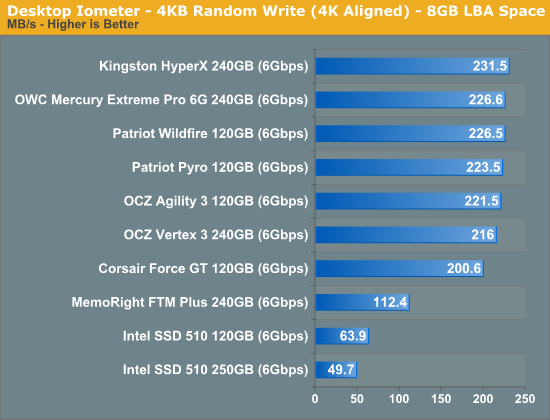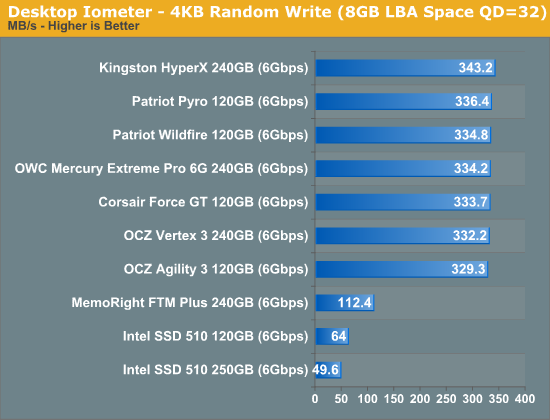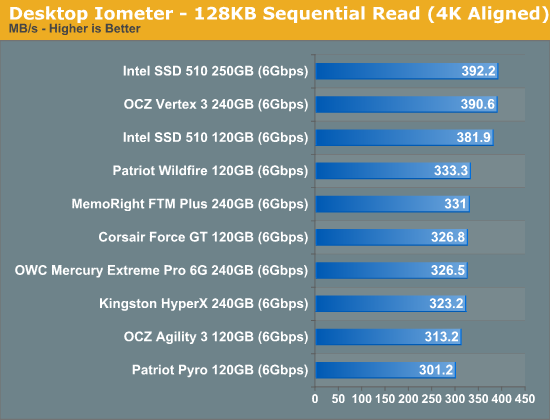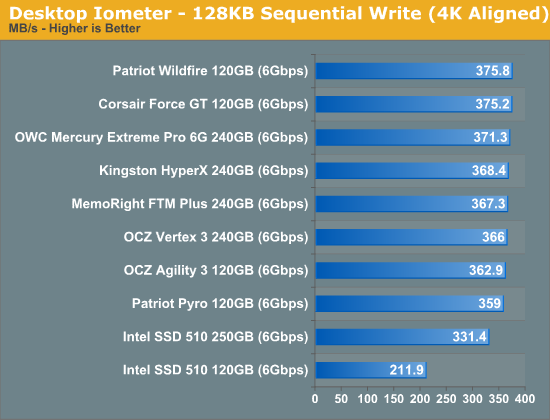The SandForce Roundup: Corsair, Kingston, Patriot, OCZ, OWC & MemoRight SSDs Compared
by Anand Lal Shimpi on August 11, 2011 12:01 AM ESTRandom Read/Write Speed
The four corners of SSD performance are as follows: random read, random write, sequential read and sequential write speed. Random accesses are generally small in size, while sequential accesses tend to be larger and thus we have the four Iometer tests we use in all of our reviews.
Our first test writes 4KB in a completely random pattern over an 8GB space of the drive to simulate the sort of random access that you'd see on an OS drive (even this is more stressful than a normal desktop user would see). I perform three concurrent IOs and run the test for 3 minutes. The results reported are in average MB/s over the entire time. We use both standard pseudo randomly generated data for each write as well as fully random data to show you both the maximum and minimum performance offered by SandForce based drives in these tests. The average performance of SF drives will likely be somewhere in between the two values for each drive you see in the graphs. For an understanding of why this matters, read our original SandForce article.

Random read performance is pretty consistent across all of the SF-2281 drives. The Patriot drives lose a bit of performance thanks to their choice in NAND (asynchronous IMFT in the case of the Pyro and Toggle NAND in the case of the Wildfire).

Most random writes are highly compressible and thus all of the SF-2281 drives do very well here. There's no real advantage to synchronous vs. asynchronous NAND here since most of the writes never make it to NAND in the first place. The Agility 3 and Vertex 3 here both use their original firmware while the newer drives are running the latest firmware updates from SandForce. The result is a slight gain in performance, but all things equal you won't see a difference in performance between these drives.
The MemoRight FTM Plus is the only exception here. Its firmware caps peak random write performance over an extended period of time. This is a trick you may remember from the SF-1200 days. It's almost entirely gone from the SF-2281 drives we've reviewed. The performance cap here will almost never surface in real world performance. Based on what we've seen, if you can sustain more than 50MB/s in random writes you're golden for desktop workloads. The advantage SandForce drives have is they tend to maintain these performance levels better than other controllers thanks to their real-time compression/dedupe logic.
Many of you have asked for random write performance at higher queue depths. What I have below is our 4KB random write test performed at a queue depth of 32 instead of 3. While the vast majority of desktop usage models experience queue depths of 0 - 5, higher depths are possible in heavy I/O (and multi-user) workloads:

All of the SF-2281 drives do better with a heavier load. The MemoRight drive is still capped at around 112MB/s here.
Sequential Read/Write Speed
To measure sequential performance I ran a 1 minute long 128KB sequential test over the entire span of the drive at a queue depth of 1. The results reported are in average MB/s over the entire test length.

The older SF-2281 firmwares did a bit better in some tests than the newer versions, hence the Vertex 3 being at the top here. All of the newer drives perform pretty similarly in our sequential read test.

The same goes for our sequential write test - all of the SF-2281 drives perform very similarly.










90 Comments
View All Comments
bernardl - Thursday, August 11, 2011 - link
I am pretty surprised by the little mention of the OWC SSD in your introduction and conclusion. It seems to belong to the top 3 perforers in every single of your tests and their product have proven extremely reliable and durable over the years.I am using 3 of their SSDs (Mac pro boot, mac mini boot and external storage for music server) and have experienced zero issue and stable/fast performance.
Cheers,
Bernard
arntc - Friday, August 12, 2011 - link
I'm not sure if I read correctly between the lines; one should stick to the previous generation of consumer SSD's if your on the prowl for a systemdisk in a notebook?If the 3-dimensional comparison of Price/Performance/Reliability is charted, which SSD would currently come out on top (subjective comments allowed)?
86waterpumper - Friday, August 12, 2011 - link
I just bought the 120mb version of the mercury extreme 6g for my sandy bridge build a few weeks ago. I sure wish I had known they were coming out with faster drives :( Oh well so far no bsod issues, and Ihope I don't see one!
FunBunny2 - Friday, August 12, 2011 - link
My understanding is that NAND is measured in bits because the controllers see the data as bits, not bytes, leveling across available (addressable) dies. Yes?vashtyphoon - Friday, August 12, 2011 - link
Thanks for the article, very informative, but it made me cringe.I just placed an order for a PC build based off of the SandyBridge guide, with the OCZ Vertex 2, but I changed the motherboard to a ASUS P8Z68-V LE, same base model as the setup that caused the BSODs with a vertex 3 on page 2.... Is this going to really miss me up or do the Vertex 2s have a better track record?
Any thoughts?
brakhage - Friday, August 12, 2011 - link
I just got 3 OCZ drives, 2 vertex3 60's, and a Solid3 120. I quickly encountered the BSOD/freeze issue on the 2 60s (OS drives). After extensive research and thread-chasing, it seems like OCZ has a solid solution, though it's not simple.Basically, you update RST and INF drivers (and throw in a BIOS update if possible), then flash the firmware (2.11), clear cmos and fire it up. I've been BSOD-free ever since... EXCEPT when I use the Solid3, which I got a few days later, and haven't flashed yet. (I'm using it for additional programs, so when I play a game that's on the Solid3, I freeze up. Maybe. It may be an overclocking issue there, I haven't had time to figure it out. I just got that Solid 3 a couple days ago - the same day I OC'd the new machine.)
Full details on this fix can be found on the OCZ forums; once in a terse post, once in a more verbose one.
So: the firmware flash is a bit of a problem. The tool they provide didn't detect my drives, and it isn't recommended to flash a drive from the OS stored on that drive. I installed windows 7 on a second (spinner) hdd, and tried the tool; it still didn't work. (Maybe because they're in RAID 0?) So I put Ubuntu on the spinner and flashed them through that with no problem.
(The HDD has since been disconnected, and I haven't gotten around to hooking it up again to flash the solid3, but I'll try to do that this weekend - hopefully that will fix this one too.)
All this said, the above posters are absolutely right - this should never have happened. However, I'm WAAYYY too impatient to wait for Sandforce to solve the problem, and that impatience extends to waiting for programs to load or for the system to boot. SSDs are like Linux - freaking awesome, but, yes, they aren't the plug-n-play, fire-up-and-forget, McDonalds-style components we've come to expect when running big name OS's. Frustrating, yes, but totally worth it.
KPOM - Saturday, August 13, 2011 - link
Given the ongoing reliability issues with the Sandforce drives, perhaps Apple is justified in using "slower" Toshiba and Samsung SSDs. I've had SSDs since my 2008 Rev B MacBook Air and haven't had a problem with them (the 2008 had a Samsung, my 2010 a Toshiba, and my 2011 a Samsung).Ao1 - Saturday, August 13, 2011 - link
Lal can you please provide some statistics to back up your claim that the 8MB bug is a plague? How many occurrences of the bug have been reported and how many 310 have been sold?Can you als please confirm why you suspect that Intel have cut corners resulting deficiencies in quality control procedures? Perhaps half of the validation team were made redundant; or is that statement just an outrageous speculation?
mikeyd55 - Saturday, August 13, 2011 - link
In 2011, for a consumer to even have to be concerned about technology issues like this, is very disconcerting and bad for everyone. Don’t release a product when it’s not stable and/or hasn’t been thoroughly tested – even if it has to cost more as a result. It’s cheaper in the end for all! It reminds me of my experiences with cell / smart phones that are continuously released to consumers despite their software / hardware/ firmware not being ready for prime time. Regarding my recent (June ‘11) SSD build: OCZ Vertex 3 MAX IOPS 120 GB (updated to firmware 2.06), no hard drive, Intel DZ68DB mb (updated to second BIOS revision), and Windows 7 Home Premium 64 bit; I’ve been fortunate, so far at least, to not have experienced any BSOD’s, although under this cloud of uncertainty, I’m especially leery of updating mb BIOS, firmware or any drivers until Sandforce gets a true handle on this problem.86waterpumper - Saturday, August 13, 2011 - link
Well I have had two bsods so far just this weekend :( System is a 2500k non- overclocked running in the normal temperature ranges. First bsod happened during a windows update so I chalked it up to that, but the 2nd one happend awhile ago with the system just sitting there idle. Looks like the owc drives for sure are affected too. Now my question is, how do I prove it is the hard drive causing the bsod lol. Also is there any newer firmware than 3.19 out yet to install or what is the fix?